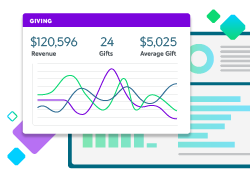How to Fundraise for a Nonprofit

Charitable giving is essential to your nonprofit, but fundraising can be one of your most daunting tasks. It requires preparation, communication, creativity, adherence to regulation, plus the enthusiasm of your supporters. Little wonder it consumes so much of your organization’s energy and budget.
Fortunately, philanthropic giving is on the rise. Blackbaud Institute’s 2022 Charitable Giving Report marked a 9% increase in overall giving from the previous year. Lending Tree reports that more than half of Americans are generous, with 56% contributing to a charity in 2021. With donations and goodwill on the upswing, it is critical to understand how to fundraise for a nonprofit. So, let’s review the basics.
The Importance of Fundraising for a Nonprofit
Most nonprofits depend at least in part on voluntary donations to fulfill their mission, sustain their operations, and evolve with the times. Fundraising could pay for all or part of your organization’s programming, salaries, and office expenses, as well as capital expenditures.
The importance of fundraising for your nonprofit, though, reaches beyond revenue:
- Raises awareness for your mission
- Makes your organization more attractive to foundations that award grants
- Builds relationships with new donors
- Refines your messaging
- Inspires volunteers
- Expands your impact in the communities you serve
- Diversifies your income stream if you’re primarily a grant-based organization
Fundraising Ideas for Nonprofits
If you are just starting out in fundraising, it’s worthwhile to think about who you will ask for support. It’s likely your nonprofit will depend on three common sources of income.
Corporate donors or commercial partnerships often provide 10%-20% of total fundraising revenue, focused on these modes of gift-making:
- Sponsorships—underwriting events, exhibits, programs
- Matching gifts—donating a 1:1 employee match
- Corporate grants—funding capital projects, large programs
- In-kind contributions—making donations of tangible goods, such as computer equipment, or services, such as marketing
Foundation grants from private or community foundations do not have to be repaid, but they do have well-defined conditions attached. Most often, foundations contribute to the following:
- Capital projects—funding building purchases, construction, renovation
- Large programs—making transformational investments tied to a specific outreach
Individual donors are responsible for up to 75% of raised funds for most nonprofits. There are two categories for individual gifts.
- Restricted: The donor specifically designates a gift to an identified project, purpose, capital need, or fund.
- Unrestricted: The donor does not designate where, when, and why you can use the funding. Your organization chooses how to use the funds. Typically, an unrestricted gift is applied to operational costs.
Every organization has unique goals and methods, but all fundraisers for nonprofits use common terminology. Consider these terms in the context of a small college seeking donations for the construction of a library.
- Campaign: This is the overall objective for raising money (“Build Our New Library”)
- Fund: This designates the specific purpose of a gift (“Book Fund” or “Building Fund”)
- Appeal: This is the solicitation that secures the gift (email blast, social media ad)
- Package: This is how the organization keeps the donor engaged (brochure, holiday card, newsletter)
No matter what you name it, there is no perfect fundraiser for all organizations. But one of these fundraising ideas for nonprofits could be perfect for yours.
Peer-to-Peer Fundraising
Peer-to-peer fundraising is as much about donor activism as it is about raising money. It is a type of DIY crowdfunding that relies on supporters, volunteers, board members, friends, and family reaching out to their personal networks on behalf of your mission.
A good choice for nonprofits with a database of passionate supporters, peer-to-peer fundraising offers many benefits to your organization:
- Encourages constituents to take an active role in your cause
- Magnifies your outreach to new supporters via an ambassador they already know
- Has the potential to raise considerable money for minimal investment
Here are some peer-to-peer ideas for your nonprofit:
P2P Event Fundraisers
People tend to respond with enthusiasm when a friend asks them to make a meaningful impact on a mission they stand behind, so these fundraisers are not a hard sell. P2P events are usually virtual, requiring no budget for a site, security, or refreshments. Promotion is primarily handled for free by your supporters. Donations can be in the form of pay-to-play or from pledges, such as $10 a mile, which your supporters collect from their contacts who can participate from anywhere in the world. Some ideas:
- Fun run
- Gaming fundraiser, binge-playing for charity on Xbox or PlayStation
- Fitness challenge
- Give It Up, to raise money while breaking a habit
- Cycling or spin event
- Garage sale
- Holiday decorating contest
- Trivia night
- Scavenger hunt
- Birthdays, graduations, and weddings
P2P Social Fundraisers
Deploying social fundraising strategies depends on your supporters uniting people around your cause and asking them to invest in your nonprofit. They do this through their social media connections, personal web pages, and community influence. Self-motivated social awareness campaigns have been known to go viral (remember the Ice Bucket Challenge for ALS?), but even a modest local fundraiser will help you raise recognition and revenue for your nonprofit.
P2P #GivingTuesday Fundraisers
A global event in which people around the world donate to the causes that matter to them, GivingTuesday is an opportunity for your nonprofit to tap into the generosity of the season. Since it is a single-day ask, supporters may sign on more readily to fundraise on your behalf, calling on the power of social media hashtags and their email contacts.
Because all P2P fundraisers provide a rich environment for lead generation, it is essential to invest in peer-to-peer fundraising software well before you launch a campaign. A high-quality P2P fundraising platform will help your nonprofit identify new supporters, engage your current champions, manage events, and raise more funds with purpose-built analytics and social networking capabilities.
Hold an Event
Hosting a fundraising event is a tried-and-true method for gathering interest and dollars for your mission. Many of the virtual events mentioned above for peer-to-peer fundraising translate easily to in-person events. Your event does not have to be large-scale to be profitable, but you can boost your budget by making a successful pitch to sponsors, detailing how your event will help them meet their business goals.
Golf tournaments, galas, fashion shows, races, and dance-a-thons are popular, or your unique supporters might rally around one of these out-of-the-box ideas:
- Polar Plunge or Mile Swim
- Paint Jam live street art event
- Adult Spelling Bee
- Dodgeball Tournament
- Speed Dating Night
- Battle of the Bands
- Wine Tasting
- Yoga at Sunset
Run a Text or Email Campaign
If you are looking for a fast and cost-effective way to build awareness, raise money, acquire new leads, and engage your current supporters, email marketing or a text campaign can give an immediate and long-term boost to your nonprofit.
Text-to-give campaigns are designed to be simple, with a quick response from prospects and current donors to a prompt to make a gift, approve a recurring gift, or take another action, such as “double the donation” for a matching gift challenge.
Email marketing can be incredibly effective if you send the right message to the right donor by segmenting your database. For instance, you would send an introductory email only to prospects; a volunteer ask only to your weekend warriors. This kind of email fundraising requires a top-notch constituent relationship management (CRM) platform. Investing in fundraising CRM software allows you to inspire and motivate your supporters with beautiful, dynamic emails, and then evaluate their effectiveness with advanced analytics tools.
Make a Crowdfunding Page
Reach a wider prospect pool and raise fast cash for your next big project by creating a crowdfunding page. Many crowdfunding sites are free for nonprofits, and you can set up your page in just a few minutes. Use striking images and give your page a compelling headline but keep all copy simple and short. Make the share factor easy by including your nonprofit’s social media buttons. In addition to asking for a one-time donation, use your page to ask for recurring gifts.
Create a Membership Program
Launching a membership program is a mutually beneficial approach to fundraising. For you, membership builds donor loyalty while creating a source of annual income for your nonprofit. Your donor base receives engagement opportunities and a sense of community in exchange for a membership fee.
Structure your membership program to incentivize the constituents you already have, setting the fee and perks at a level appropriate to their means and interests. Here are some ideas:
- Members-only events and newsletters
- Special access and discounts
Other Fundraising Tips to Keep in Mind
Fundraising should be an area of ongoing improvement for your nonprofit. Each campaign, event, and even failure offers a point of instruction to help you do better next time. Some final reminders:
- Conduct quality prospect research. Fundraising software for nonprofits will help you identify best-fit leads.
- Make a fundraising plan. In addition to identifying target donors, four steps are key: goal setting, communicating, donor nurturing, and creating effective fundraising materials, including social media posts and web pages.
- Offer multiple ways to give. Explore the best platforms to provide convenient options for payment, from automatic recurring gifts to PayPal to Venmo.
- Stay compliant. Fundraising activities are regulated. It’s likely your nonprofit needs to register in the state where it solicits donations.
- Show your appreciation. Pull out all the stops to deliver a creative and genuine thank you to your donors, via video, phone call, email, or donor wall.
The Nonprofit CRM Built for Fundraisers
Find out how Blackbaud’s Raiser’s Edge NXT® fits your organization.

